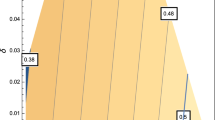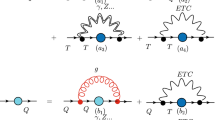Abstract
The authors consider the mechanism of formation of techniquark states which have a vectorlike interaction with the standard bosons. It is shown that the simplest variant of the vectorlike technicolor does not contradict to the new physics restrictions. It is suggested that the technibaryon scalar states are regarded as dark matter candidates.
Similar content being viewed by others
References
C. Aad et al. (ATLAS Collab.), “Observation of a new particle in the search for the standard model Higgs boson with the ATLAS detector at the LHC,” Phys. Lett. B 716, 1–29 (2012).
S. Chatrchyan et al. (SMS Collab.), “Observation of a new boson at a mass of 125 GeV with the CMS experiment at the LHC,” Phys. Lett. B 716, 30–61 (2012).
ATLAS Collab., “Constraints on new phenomena via Higgs coupling measurements with ATLAS detector,” ATLAS-CONF-2014-010 (CERN, Genewa, 2014).
S. Weinberg, “Implication of dynamical symmetry breaking,” Phys. Rev. D: Part. Fields 13, 974996 (1976).
L. Susskind, “Dynamics of spontaneous symmetry breaking in the Weinberg-Salam theory,” Phys. Rev. D: Part. Fields 20, 2619–2625 (1979).
E. H. Simmons, “Phenomenology of a technicolor model with heavy scalar doublet,” Nucl. Phys. B 312, 253–268 (1989).
S. Samuel, “Bosonic technicolor,” Nucl. Phys. B 347, 625–650 (1990).
A. Kagan and S. Samuel, “Renormalization group aspects of bosonic technicolor,” Phys. Lett. B 270, 37–44 (1991).
C. D. Carone, “Technicolor with a 125 GeV Higgs boson,” Phys. Rev. D: Part. Fields 86, 055011 (2012).
S. Dimopoulos and L. Susskind, “Mass without scalars,” Nucl. Phys. B 155, 237–252 (1979).
E. Eichten and K. D. Lane, “Dynamical breaking of weak interaction Symmetries,” Phys. Lett. B 90, 125–130 (1980).
M. E. Peskin and T. Takeuchi, “Estimation of oblique electroweak corrections,” Phys. Rev. D: Part. Fields 46, 381–409 (1992).
F. Sannino, “Conformal dynamics for TeV physics and cosmology,” Acta Phys. Polon. B 40, 3533–3744 (2009).
T. W. Appelquist, D. Karabali, and L. C. R. Wijewardhana, “Chiral hierarchies and flavor-changing neutral currents in hypercolor,” Phys. Rev. Lett. 57, 957–960 (1986).
F. Sannino and K. Tuominen, “Orienfold theory dynamics and symmetry breaking,” Phys. Rev. D: Part. Fields 71, 051901(R) (2005).
R. Foadi, M. T. Frandsen, T. A. Ryttov, and S. Sannino, “Minimal walking technicolor: setup for collider physics,” Phys. Rev. D: Part. Fields 76, 055005 (2007).
R. Pasechnik, V. Beylin, V. Kuksa, and G. Vereshkov, “Chiral-symmetric technicolor with standard model Higgs,” Phys. Rev. D: Part. Fields 88, 075009 (2013).
R. Pasechnik, V. Beylin, V. Kuksa, and G. Vereshkov, “Vector-like technineutron dark matter: is a QCD-type technicolor ruled out by XENON 100?,” Eur. Phys. J. C 74, 2728 (2014).
M. K. Volkov and A. E. Radzhabov, “The NambuJona-Lasinio model and its development,” Phys. Usp. 49, 551 (2006).
K. A. Olive et al. (Particle Data Group), “The review of particle physics,” Chin. Phys. C 38, 090001 (2014).
Author information
Authors and Affiliations
Corresponding author
Additional information
Original Russian Text © V.A. Beylin, G.M. Vereshkov, V.I. Kuksa, 2016, published in Pis’ma v Zhurnal Fizika Elementarnykh Chastits i Atomnogo Yadra, 2016.
Deceased.
Rights and permissions
About this article
Cite this article
Beylin, V.A., Vereshkov, G.M. & Kuksa, V.I. Model of vectorlike technicolor. Phys. Part. Nuclei Lett. 13, 19–25 (2016). https://doi.org/10.1134/S1547477116010039
Received:
Published:
Issue Date:
DOI: https://doi.org/10.1134/S1547477116010039




